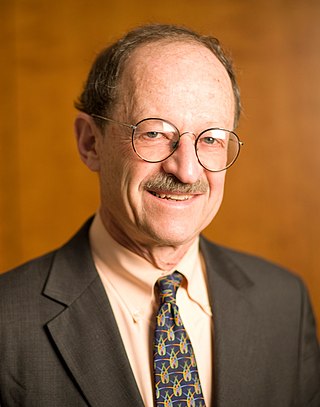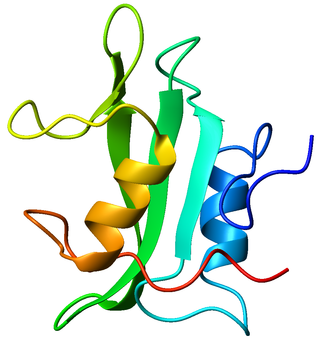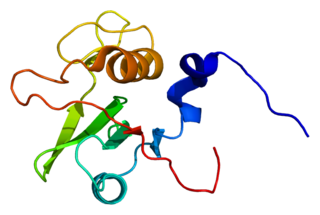Related Research Articles

An oncogene is a gene that has the potential to cause cancer. In tumor cells, these genes are often mutated, or expressed at high levels.

Retroposons are repetitive DNA fragments which are inserted into chromosomes after they had been reverse transcribed from any RNA molecule.

A tyrosine kinase is an enzyme that can transfer a phosphate group from ATP to the tyrosine residues of specific proteins inside a cell. It functions as an "on" or "off" switch in many cellular functions.

Harold Eliot Varmus is an American Nobel Prize-winning scientist. He is currently the Lewis Thomas University Professor of Medicine at Weill Cornell Medicine and a senior associate at the New York Genome Center.

John Michael Bishop is an American immunologist and microbiologist who shared the 1989 Nobel Prize in Physiology or Medicine with Harold E. Varmus and was co-winner of 1984 Alfred P. Sloan Prize. He serves as an active faculty member at the University of California, San Francisco (UCSF), where he also served as chancellor from 1998 to 2009.

Lck is a 56 kDa protein that is found inside specialized cells of the immune system called lymphocytes. The Lck is a member of Src kinase family (SFK), it is important for the activation of the T-cell receptor signaling in both naive T cells and effector T cells. The role of the Lck is less prominent in the activation or in the maintenance of memory CD8 T cells in comparison to CD4 T cells. In addition, the role of the lck varies among the memory T cells subsets. It seems that in mice, in the effector memory T cells (TEM) population, more than 50% of lck is present in a constitutively active conformation, whereas, only less than 20% of lck is present as active form of lck. These differences are due to differential regulation by SH2 domain–containing phosphatase-1 (Shp-1) and C-terminal Src kinase.
Rous sarcoma virus (RSV) is a retrovirus and is the first oncovirus to have been described. It causes sarcoma in chickens.
The gag-onc fusion protein is a general term for a fusion protein formed from a group-specific antigen ('gag') gene and that of an oncogene ('onc'), a gene that plays a role in the development of a cancer. The name is also written as Gag-v-Onc, with "v" indicating that the Onc sequence resides in a viral genome. Onc is a generic placeholder for a given specific oncogene, such as C-jun..

Proto-oncogene tyrosine-protein kinase Fyn is an enzyme that in humans is encoded by the FYN gene.

Tyrosine-protein kinase HCK is an enzyme that in humans is encoded by the HCK gene.

Proto-oncogene tyrosine-protein kinase Src, also known as proto-oncogene c-Src, or simply c-Src, is a non-receptor tyrosine kinase protein that in humans is encoded by the SRC gene. It belongs to a family of Src family kinases and is similar to the v-Src gene of Rous sarcoma virus. It includes an SH2 domain, an SH3 domain and a tyrosine kinase domain. Two transcript variants encoding the same protein have been found for this gene.

Proto-oncogene tyrosine-protein kinase Yes is a non-receptor tyrosine kinase that in humans is encoded by the YES1 gene.

Gardner-Rasheed feline sarcoma viral (v-fgr) oncogene homolog, also known as FGR, is a protein which in humans is encoded by the FGR gene.

Tyrosine-protein kinase Fes/Fps also known as proto-oncogene c-Fes/Fps is an enzyme that in humans is encoded by the FES gene. FES was originally cloned as a retroviral oncogene from feline (v-FES) and avian (v-FPS) sarcomas. This triggered the subsequent identification and cloning of the cellular FES (c-FES) genes in birds and mammals.
Avian sarcoma leukosis virus (ASLV) is an endogenous retrovirus that infects and can lead to cancer in chickens; experimentally it can infect other species of birds and mammals. ASLV replicates in chicken embryo fibroblasts, the cells that contribute to the formation of connective tissues. Different forms of the disease exist, including lymphoblastic, erythroblastic, and osteopetrotic.
A non-receptor tyrosine kinase (nRTK) is a cytosolic enzyme that is responsible for catalysing the transfer of a phosphate group from a nucleoside triphosphate donor, such as ATP, to tyrosine residues in proteins. Non-receptor tyrosine kinases are a subgroup of protein family tyrosine kinases, enzymes that can transfer the phosphate group from ATP to a tyrosine residue of a protein (phosphorylation). These enzymes regulate many cellular functions by switching on or switching off other enzymes in a cell.
Peter K. Vogt is an American molecular biologist, virologist and geneticist. His research focuses on retroviruses and viral and cellular oncogenes.
Joan S. Brugge is the Louise Foote Pfeiffer Professor of Cell Biology and the Director of the Ludwig Center at Harvard Medical School, where she also served as the Chair of the Department of Cell Biology from 2004 to 2014. Her research focuses on cancer biology, and she has been recognized for her explorations into the Rous sarcoma virus, extracellular matrix adhesion, and epithelial tumor progression in breast cancer.
Karen Beemon is an American molecular biologist and professor of biology at Johns Hopkins University known for her research on RNA viruses and viral oncogenesis.
Kimberly W. Anderson is an American chemist. She is the Gill Eminent Professor of Chemical Engineering and Associate Dean for Administration and Academic Affairs in the College of Engineering at the University of Kentucky.
References
- ↑ Vogt PK (September 2012). "Retroviral oncogenes: a historical primer". Nat. Rev. Cancer. 12 (9): 639–48. doi:10.1038/nrc3320. PMC 3428493 . PMID 22898541.
- ↑ Swanstrom, R; Parker, R C; Varmus, H E; Bishop, J M (May 1983). "Transduction of a cellular oncogene: the genesis of Rous sarcoma virus". Proceedings of the National Academy of Sciences. 80 (9): 2519–2523. doi: 10.1073/pnas.80.9.2519 . PMID 6302692.
- ↑ Stehelin D, Fujita DJ, Padgett T, Varmus HE, Bishop JM (1977). "Detection and enumeration of transformation-defective strains of avian sarcoma virus with molecular hybridization". Virology. 76 (2): 675–84. doi:10.1016/0042-6822(77)90250-1. PMID 190771.
- ↑ Rudd CE, Trevillyan JM, Dasgupta JD, Wong LL, Schlossman SF (July 1988). "The CD4 receptor is complexed in detergent lysates to a protein-tyrosine kinase (pp58) from human T lymphocytes". Proc. Natl. Acad. Sci. U.S.A. 85 (14): 5190–4. Bibcode:1988PNAS...85.5190R. doi: 10.1073/pnas.85.14.5190 . PMC 281714 . PMID 2455897.
- ↑ Czernilofsky AP, Levinson AD, Varmus HE, Bishop JM, Tischer E, Goodman HM (September 1980). "Nucleotide sequence of an avian sarcoma virus oncogene (src) and proposed amino acid sequence for gene product". Nature. 287 (5779): 198–203. Bibcode:1980Natur.287..198C. doi:10.1038/287198a0. PMID 6253794. S2CID 4231060.
- ↑ Smart JE, Oppermann H, Czernilofsky AP, Purchio AF, Erikson RL, Bishop JM (October 1981). "Characterization of sites for tyrosine phosphorylation in the transforming protein of Rous sarcoma virus (pp60v-src) and its normal cellular homologue (pp60c-src)". Proc. Natl. Acad. Sci. U.S.A. 78 (10): 6013–7. Bibcode:1981PNAS...78.6013S. doi: 10.1073/pnas.78.10.6013 . PMC 348967 . PMID 6273838.